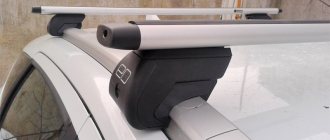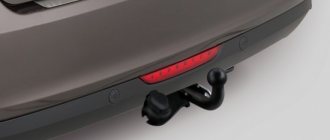Installing gas equipment on a car is an option that is gaining more and more popularity among drivers every year. In Russia, this service is also becoming popular, and this is due to the constant rise in prices for gasoline and gas, which forces drivers to look for ways to save money. The largest automobile concert, AvtoVAZ, is already beginning to equip some of its car models with gas equipment directly at the factory. These include Lada Vesta CNG. Let's learn more about the pros and cons of installing LPG on Vesta, and figure out whether it is profitable to use LPG on a domestic car.
Content:
- 1 Advantages and disadvantages of gas equipment
- 2 Options and prices
- 3 Lada Vesta CIS: technical characteristics, description
- 4 Gas consumption and range
- 5 How and where to fill a car with gas
- 6 Self-installation of gas equipment on Lada Vesta
A biofuel system can be thought of as a hybrid of gasoline and gas. The car's name now includes three additional letters, CNG, which stand for Compression Natural Gas. Today, the cost of re-equipping a standard Lada Vesta can cost 170,000 rubles. In turn, a new car equipped with gas equipment costs 30,000 rubles more. Therefore, the news that the Lada Vesta CNG will receive a sports version was received very positively.
Deciding on the generation of HBO and its manufacturer
The decision which generation of HBO to choose, first of all, depends on the financial capabilities of the driver, however, if we consider the most favorable generation of HBO for Vesta, then it will certainly be the fourth. This is due to the fact that the engine of this car model has a simple design and does not require high-tech equipment.
You might be interested >> Gas equipment for Pajero 4
Earlier versions can also be installed on cars, but they are less advanced, and the fifth generation is designed for installation in vehicles equipped with turbocharged engines that use direct fuel injection technology. And since such engines are not used when assembling the Lada Vesta, there is no point in installing the 5th generation.
As for the choice of manufacturer, it all depends on the financial capabilities of the driver and the individual requirements that he will place on LPG. As a piece of advice, below are 5 companies whose products are in greatest demand in the gas equipment market:
- Italian company Lovato. The equipment has a reasonable price and is reliable during operation. It is very popular both in the Russian and foreign LPG markets.
- Dutch PRINS. Considered one of the most elite brands; A distinctive feature is the development of injection systems using exclusive technologies.
- Polish STAG equipment. It has a convenient menu translated into Russian and an optimal price-quality ratio.
- Turkish company ATIKER. It is very popular in its homeland and is in serious demand in other countries. The equipment has a high build quality and is constantly tested to ensure compliance with the latest quality and safety standards.
- Italian brand BRC. A distinctive feature is the long working life of the manufactured equipment and one of the longest warranty periods of service among all gas equipment manufacturers on the world market.
↑ Advantages and disadvantages of gas equipment
Gas equipment in any car means, first of all, savings. But there are other advantages and disadvantages that are also characteristic of Vesta CNG.
The new car has many advantages compared to the standard model:
- Increased engine life, subject to proper operation and timely maintenance of equipment.
- Low tendency to form deposits and, accordingly, soot.
- Saving money, which will be especially noticeable as the mileage increases.
- Increased reliability of engine operation due to lower combustion temperature when injecting a small portion of gasoline during gas use.
- Increased travel range. A car can travel 400 km on gas, and 600 km on petrol. In total, it can travel up to 1000 km. It is assumed that the hybrid fuel system will become an alternative to the diesel one.
The new Lada Vesta on gas has its drawbacks. Firstly, the car is equipped with gas equipment that runs on methane. This type of gas is less common than propane. It is especially difficult to find methane outside the city and on the periphery. Often gas stations are located next to the “pipeline”, so traveling to a remote place to refuel is inconvenient and unprofitable.
{banner_banner1}
Secondly, gas equipment takes up some working space in the car, including in the trunk. This slightly reduces the amount of free space that can be used to load luggage. Thirdly, the presence of reclining rear backrests is pointless. Again, due to the presence of a cylinder in the trunk.
Propane or methane?
There are heated debates on this matter, with the parties giving various arguments. However, in Russia and the CIS countries the vast majority of passenger cars are equipped with propane units.
Methane is a rare type of gas in passenger cars.
Their cylinders are lighter than methane ones, their capacity is larger, and, most importantly, the network of methane filling stations is much less extensive. Even in many large cities there are only a few such gas stations, and in small regional centers, the residents of which Lada Vesta is also aimed at, usually do not have them at all. Consequently, the choice is obvious - all the advantages of methane (cheapness, purity, high octane number, etc.) are largely undermined by the underdeveloped network of gas stations and the significant dimensions and weight of the cylinders. It is not surprising that such gas is usually used in freight transport.
The network of propane gas stations is much wider.
Propane itself is a synthetic gas (liquefied), which is obtained by processing oil, as well as petroleum gases (condensed). Under conditions of low pressure and normal temperature, the fuel is visually a mixture of propane, ethane and butane with an octane rating of 100 units.
↑ Options and prices
Visually, the modernized model cannot be distinguished from the regular Lada Vesta. The only difference is the presence of a nameplate on the trunk door. Everything else remains unchanged. The designers made no adjustments to the model.
The buyer can choose a model in the following color:
- white;
- light gray;
- garfit;
- dark gray;
- black;
- golden;
- blue;
- yellow;
- red;
- gray-blue.
There are also no obvious changes in the interior. All controls are located in the old way, there are all the necessary buttons with switches. One round button has appeared, with which you can switch from gasoline fuel to gas equipment. The presence of a diode indicator allows you to determine the presence of fuel in the cylinder.
{banner_banner3}
Perhaps over time the switch will be located on the center console, where the multimedia center is located. An indicator of the amount of fuel and its consumption can be found on the on-board computer screen.
It is expected that the Lada Vesta HBO station wagon will also enter the market very soon. This version will have plenty of trunk space. Therefore, lovers of sufficient space in the luggage compartment will also not be deprived. In addition to the station wagon, a crossover with gas equipment called Vesta SW Cross CNG will also hit the market.
Bi-fuel Vesta is already being sold at dealerships. The car, equipped in the basic version called Standart+Start, costs 609 thousand rubles. For a model in the Comfort configuration you will have to pay a little more - 629 thousand rubles. If you want to drive a car in the Lux configuration, you will have to pay from 692 thousand to 716 thousand rubles, respectively.
Installation and Maintenance
Converting a gasoline version into a hybrid version, according to experts, will cost from 30 thousand to 170 thousand rubles. But due to the fact that the state provides financial support, the factory model will be only 30 thousand more expensive than a regular gasoline model. This leads to another disadvantage of LPG - it does not begin to make a profit immediately, since its installation requires serious investments. Therefore, equipping a car with such systems is carried out taking into account the future, and not immediate payback.
Maintenance of this type of equipment is not much different from any other and will not hit the driver’s wallet. Typically, the working life of all gas equipment parts has a serious reserve and, with proper installation and operation, can serve the owner for a very long and productive time. In addition, I would like to note that the Lada Vesta with gas equipment has many positive reviews.
Note! You should not save money on specialists if you bought a Lada Vesta with LPG not from the factory, but install it yourself.
↑ Lada Vesta CIS: technical characteristics, description
The 90-liter cylinder, which is located in the trunk, can hold up to 22 m3 of methane. The operating temperature ranges from 40-50 degrees Celsius. As noted above, if you switch to gas, the car loses power from 106 hp. With. up to 96 l. With. But during normal driving around the city or outside it, it is almost impossible to distinguish the behavior of a car on different types of fuel.
{banner_banner2}
The official dealer is already selling various vehicle configuration options. A station wagon version will be released very soon. By the way, the car is already undergoing test drives. Videos of the first tests are already available on various resources.
The car passed test drives, and the manufacturers received permission to sell it. A methane sedan is safe to operate in any conditions. The car received good scores in crash tests. All connections are reliable and secure. When the front, side and rear of the car were tested, the cylinder remained sealed.
What about registration?
Vesta CNG is not a single car equipped with LPG, but a full-fledged serial modification, the first of its kind in Russia. The car has received vehicle type approval (VTA), it will have a factory warranty, an appropriately supplemented service book and a note in the vehicle title about a dual power system. Certification crash tests - frontal, side, rear impact - were passed successfully: there were no gas leaks in any of the tests, the gas equipment remained sealed.
On vehicles not equipped with LPG at the factory, the filler fitting is usually located under the hood. At the gas station, you need to open the gas supply, and after refueling, release the pressure. On the serial Vesta CNG refueling is much more reminiscent of a regular gasoline one.
On vehicles not equipped with LPG at the factory, the filler fitting is usually located under the hood. At the gas station, you need to open the gas supply, and after refueling, release the pressure. On the serial Vesta CNG refueling is much more reminiscent of a regular gasoline one.
When purchasing a car, registering it and further using it, no additional actions will be required from the owner. Inspection and maintenance of gas equipment are timed to coincide with routine maintenance, which Vesta undergoes every 15,000 km. All operations with gas equipment fall on the AVTOVAZ dealer network. According to forecasts, prices for maintenance will be only slightly higher than for gasoline cars, because the only significant operations (in addition to control and inspection) will be the regular change of the air filter cartridge.
↑ Gas consumption and power reserve
The Lada Vesta CNG car has a standard VAZ 21129 engine. The engine displacement is 1.6 liters. Its power is 106 hp. With. The torque value is 136 Nm. When switching to eco-gas, the vehicle's power decreases. The gearbox is five-speed manual. Lada Vesta CNG has a methane consumption of 6.2 m3/100 km.
When driving on gasoline, the engine consumes about 7 liters of fuel per 100 km, while gas consumption is 6 m3. Today the cost of methane is about 14 rubles. It's not difficult to calculate the savings. It's really beneficial.
Is he going?
Judging by the passport data, when switching to gas, Vesta loses 11 hp. power and 15 Nm of torque. Acceleration to hundreds on gas takes 12.2 seconds, while on gasoline it takes 11.8. It is difficult to feel a decrease in power during measured driving. The VAZ-21129 engine fully retains its character, readily spinning up only after 3000 rpm. If you don’t drop the tachometer needle lower, the dynamics of the gas Vesta will satisfy everyone.
Filling fitting, cylinder and gas line leading under the hood. In addition to the receiver, which reduces the pressure to operating pressure, a controller has appeared in the engine compartment that monitors gas consumption. The gasoline tank located under the rear seat remains standard.
Filling fitting, cylinder and gas line leading under the hood. In addition to the receiver, which reduces the pressure to operating pressure, a controller has appeared in the engine compartment that monitors gas consumption. The gasoline tank located under the rear seat remains standard.
In most cases, it is possible to determine what fuel the car is running on only by the indicator above the switch button or during sudden starts from a standstill and during overtaking spurts, when a slight lack of traction is still noticeable. The engine starts always on gasoline (the gas reducer needs a little preliminary warming up), then you can switch to gas power. A forced transition (you need to press a button) from gas to gasoline and back takes a couple of seconds and is accompanied by a soft click of the valve behind the back of the rear seat. There is also automatic switching: if the gas cylinder is empty, the system itself will switch to gasoline power. But in some modes, even when driving on methane, gasoline consumption is small, about 1 l/100 km - it is injected in small doses into the cylinders to reduce the combustion temperature of the mixture and preserve the engine's life.
↑ How and where to fill a car with gas
As we said above, there are not many gas stations capable of providing the Lada Vesta with methane. There are no more than 300 such places throughout the country. But this is not so bad when compared with 2016, when there were only 30 such stations in the country. According to plans, 25 more places will be built in the country this year where it will be possible to refuel with methane.
A car with gas equipment is of particular interest to residents of the southern and Caucasian regions. It is in this direction that most new stations are being built. The popularity of cars largely depends on the development of this direction.
In order to refuel the dual-fuel version, an adapter is issued at a special station, which snaps onto the fitting under the hatch. Next, you need to attach the other end to the column and perform refueling.
Special mobile stations with gas fuel can partially correct the situation. PAGZ is a semi-trailer with 16 cylinders holding 5 thousand cubic meters of gas. This is enough to power 100 GAZelle cars and 250 VESTA passenger cars using methane.
{banner_banner1}
These mobile fuel stations are reliable and provide fast refueling. At the same time, they can be quickly refueled at points where propane and methane are available. Thanks to this, they always have gas in them. Today they are not widely used. You can meet in Stavropol. In the near future it will appear between Moscow and St. Petersburg.
How does it work?
A Vesta bifuel cylinder holds 90 liters, which corresponds to 21–22 cubic meters of gas (the exact volume value is determined by the density of the gas and the pressure in the filling column). The working pressure in the cylinder is 20 MPa at 15°C, and the test pressure reaches 30 MPa. Operating temperature range - from -40 to 55°C.
On a full gas charge, you can travel 300–400 km, and it will cost three times less than with gasoline. And since the 55-liter gas tank remained untouched, Vesta CNG can cover more than a thousand kilometers at one refueling with both types of fuel.
The possibilities for transforming the interior have been reduced to a minimum, but this Vesta travels 1000 kilometers without refueling.
The possibilities for transforming the interior have been reduced to a minimum, but this Vesta travels 1000 kilometers without refueling.
The cylinder ate up a fair share of the usable space of the 480-liter trunk. From it to the rear wall of the luggage compartment no more than five 1.5-liter bottles of mineral water will fit. This (based on the fact that the bottle diameter is 92 mm) is only 460 mm. A regular petrol Vesta has a trunk depth of 920 mm - twice as much. There is also almost no space left above the cylinder - well, you can squeeze in a couple of flat bags. By eye, the actual volume of the trunk has been reduced by almost half (there are no exact factory data yet).
A Chinese 90-liter cylinder holds 18–21 cubic meters. m of gas. Alas, its installation reduced the depth of the trunk by half.
A Chinese 90-liter cylinder holds 18–21 cubic meters. m of gas. Alas, its installation reduced the depth of the trunk by half.
The false floor covering the spare tire has also become half as long. Below that is a new tool tray that wraps around the spare tire, which is partially hidden by the cylinder. It's not scary: getting the spare tire is not much more difficult.
The steel gas pipeline is laid under the bottom and is not covered with anything from below - however, like the gasoline line. The gas pipeline goes under the hood to the receiver, which reduces the pressure and sends the gas further into the ramp, from where it is distributed to the injectors. Under the hood, on the left in the direction of travel, there is a controller that, in case of any unregulated gas consumption, shuts off its supply.
Metal composite cylinder - Chinese manufacturer Sinoma. They say it turned out to be the best in strength. Its guaranteed service life is 15 years, subject to re-examination every five years. The cylinder is clearly visible from the cabin when any part of the rear seat back is reclined - in fact, it blocked the entire opening, so it is now impossible to transport large loads. The valve is accessible from the passenger compartment: it must be closed if the machine is not used for a long period of time. The rest of the gas equipment is from the Italian company Emer.
The trunk area now looks like this. An empty plastic container rattles as it goes.
The trunk area now looks like this. An empty plastic container rattles as it goes.
The filling nipple is hidden under the gas tank flap next to the gasoline filler neck. Any Gazprom CNG filling station will give you an adapter that needs to be snapped onto the fitting. The adapters are mostly Western-made, but we have our own - Russian, more compact, but a little more difficult to use: before snapping it onto the fitting, it must be unscrewed. But in general, the refueling process is simple with any adapter: you need to snap it onto the fitting and insert the gun into it. I gave the money to the cash register and the gas started flowing.
Fully pumping a Vesta cylinder, in theory, takes 10 minutes, but we did it faster - it all depends on the pressure in the column.
↑ Self-installation of gas equipment on Lada Vesta
When installing gas equipment yourself, the most important question remains: which gas to choose? The manufacturer chose to use methane. But most gas stations in the country have propane. Today we can say with confidence that propane has many advantages.
In addition to more refills, other positive qualities should be noted. Firstly, the weight of propane cylinders is lower than that of methane. Secondly, they have a large capacity. Therefore, most car owners are inclined towards propane. Perhaps the creation of a gas-powered car that uses methane will change this trend.
Prejudices of opponents of HBO
They usually relate to 2 points:
- Safety;
- Reliability.
You should not believe theories that the presence of a gas cylinder on board Vesta increases the risk of an explosion. Cylinders, made of almost 4 mm steel, and also equipped with safety valves and other shut-off valves, are much more durable than gas tanks and can withstand very strong impacts in an accident. Moreover, even a break in the fuel lines will not cause detonation. In addition, the ignition temperature of the gas-air mixture of propane is higher than that of gasoline vapor, and the mixture itself is heavier than air.
The strength of HBO cylinders meets the highest standards. They are much stronger than the standard Vesta gas tank.
But there is also an opinion that installing gas equipment will over time negatively affect the condition of Vesta’s fuel system, even to the point of replacing the fuel pump. However, this happens to those drivers who begin to save excessively. After all, the Lada’s power unit starts up on gasoline. Therefore, it is necessary to prevent the gas tank from being completely empty, as this leads to accelerated wear of the gas pump.
With a constant minimum level or absence of gasoline, the Vesta fuel pump wears out faster.
Comparison of Lada Vesta CNG 2022 with Renault Logan and Kia Rio
| Comparison parameter | CNG Classic | Renault Logan Access | KIA Rio Classic |
| Engines | |||
| Minimum price in rubles | 609 000 | 499 000 | 699 000 |
| Base motor power (hp) | 106 | 82 | 100 |
| At rpm | 5800 | 5000 | 6000 |
| Maximum torque in Nm | 148 | 134 | 135 |
| Maximum speed in km/h | 172 | 172 | 185 |
| Acceleration 0 – 100 km/h in seconds | 12,6 | 11.9 | 12.2 |
| Fuel consumption (highway/average/city) | 5,5/9,3/6,9 | 9.8/5.8/7.2 | 7.2/4.8/5.7 |
| Number of cylinders | 4 | 4 | 4 |
| engine's type | Petrol | ||
| Working volume in l. | 1,6 | 1,6 | 1,4 |
| Fuel | AI-92/95/methane | AI-92/95 | AI-95 |
| Fuel tank capacity | 55 l/90 l cylinder | 50 l | 55 l |
| Transmission | |||
| Drive unit | Front | ||
| Transmission | Manual transmission | ||
| Number of gears | 5 | 5 | 6 |
| Chassis | |||
| Availability of alloy wheels | — | — | — |
| Tires | R15 | R15 | R15 |
| Body | |||
| Number of doors | 5 | 5 | 5 |
| Body types | Sedan | ||
| Curb weight in kg | 1150 | 1106 | 1080 |
| Permitted weight (kg) | 1580 | 1545 | 1530 |
| Dimensional | dimensions | ||
| Length (mm) | 4410 | 4346 | 4410 |
| Width (mm) | 1764 | 1732 | 1730 |
| Height (mm) | 1497 | 1517 | 1470 |
| Wheelbase (mm) | 2635 | 2634 | 2600 |
| Ground clearance/clearance (mm) | 178 | 160 | 160 |
| Salon | |||
| Trunk volume | 390 | 510 | 480 |
| Options | |||
| ABS | + | + | + |
| On-board computer | + | — | + |
| central locking | + | — | + |
| Rear electric windows | — | — | — |
| Airbags (pcs.) | 1 | 1 | 2 |
| Air conditioner | — | — | + |
| Heated mirrors | — | — | + |
| Front electric windows | + | + | + |
| Heated seats | — | — | — |
| Fog lights | — | — | — |
| Steering wheel adjustment | + | + | + |
| Seat adjustment | — | + | + |
| Stabilization system | — | — | + |
| Audio system | — | — | — |
| Metallic color | 12,000 rub. | 14990 rub. | + |
Other reviews
Against the background of the constant appearance of new cars on the world market, the Lada Vesta of the 2015 model year is not such a new product. However, it can still be considered the discovery of the Russian car market thanks to its very modern appearance and well-thought-out technical “stuffing”. The sedan's exterior was designed by ex-Mercedes-Benz and Volvo designer Steve Mattin, and was among the first people lucky enough to sit in it.
The raised cross-country hatchback Lada Xray, which AvtoVAZ dubbed a crossover for advertising purposes, is called by many the highest quality model of the domestic manufacturer, and there is indeed reason for this. Firstly, there is an abundance of high quality imported parts, and secondly, this car has decent ground clearance and a proprietary 1.8-liter engine.
5- and 7-seater Lada Largus station wagons appeared on the Russian market in 2012, becoming a kind of continuation of the cheapest Renault Logan model, only under the auspices of a domestic manufacturer. As you might guess, the Logan-like Largus turned out to be the first Lada car built on the basis of the budget B0 platform, on the basis of which a number of Lada, Renault and Nissan models were designed.
If the image doesn’t bother you, you like the ground clearance, like a jeep, and in addition, you’ll admire the large capacity in the form of a 5/7-seater interior and a huge trunk, and “not expensive” - that’s all, we’ve arrived. Yes, not on anything, but on a raised Lada Largus with a talking Cross prefix and, of course, DNA from Renault Logan. This model, first presented to Russians in 2015, has no competitors.
The domestic auto industry never ceases to amaze. For example: when the Russian press first said that AvtoVAZ was preparing a “sports” version of the second Lada Kalina in a hatchback body, it was more difficult to get a new product for a test drive than another Bentley or Mercedes. Amazing, right? For VAZ people there is nothing special about this: not many significant new products are released after all.
What is a 3- or 5-door Lada 4×4 with the Urban prefix? Some kind of supernova Niva? In relation to an off-road passenger car from the glorious city of Togliatti, these words smack of piercing irony. New, of course - it’s been around for almost 40 years, of which 10 years the model has not been called Niva. But somehow I can’t seem to forget about my “maiden name”... So, what does “urban” promise?
It will not be a revelation to anyone that AvtoVAZ literally slept through the SUV boom. And one day they decided to somehow make up for this matter and in the summer of 2014 they presented to the general public the all-terrain all-terrain station wagon Lada Kalina Cross, built on the basis of Kalina 2. In order to become a “Cross”, the model had to survive not only external, but also internal, technical.
Vesta runs on methane
1K 7 min.
The Lada Vesta CNG car worked in the editorial office for about a month. The model differs from the standard version in the ability to use two types of fuel - gasoline and methane. We tested the car in real use, and also assessed the infrastructure of gas stations in Samara.
Photo: Yuri Strelets, Kommersant
The Lada Vesta CNG car worked for almost a month at the Kommersant-Volga editorial office. The difference between this model is the ability to use two types of fuel. The car is produced with a serial gas cylinder installation designed for the use of compressed natural gas - methane.
The model in the dual-fuel CNG version has been produced since 2022. For the first time in the history of the Lada brand, mass production of a car with a gas cylinder installation began. A cylinder with a capacity of 90 liters, designed for 18 cubic meters of gas, is located in the trunk of the car behind the back of the rear sofa. A fully fueled car can travel more than 1000 kilometers without refueling. When the gas in the cylinder runs out, the engine power is automatically switched to gasoline. It is also possible to force a change in the fuel used using the gas/gasoline switch. In the event of a leak, the gas is effectively dispersed into the atmosphere.
Photo: Yuri Strelets, Kommersant
Externally, the car is practically no different from the Vesta, which runs on gasoline. You can distinguish the gas model by the markings on the trunk lid. In addition, visually the car looks slightly lower due to the significant load on the rear axle - there is an 18 cubic meter gas cylinder in the trunk. m. For the same reason, there is practically no trunk in the car, and the back of the rear seat does not fold.
Photo: Yuri Strelets, Kommersant
Among the changes in the cabin is a fuel type switch that has appeared on the center console, equipped with indicators that look like five glowing lights. If all five lights are on, this means that the cylinder is fully filled. As gas is used, the lights go out one after another, and when the gas runs out, the red indicator lights up.
In addition, Lada Vesta cars have a power reserve indicator on the dashboard, which shows the approximate mileage that the car will travel to the nearest gas station. However, this indicator only works when using gasoline.
Photo: Yuri Strelets, Kommersant
We got a car for testing in the maximum configuration - in fact, this Vesta can have everything except a combined seat trim, where eco-leather is used.
Among the options, it is worth noting the presence of a rear view camera, standard navigation and illumination of entry and exit points in the front doors. In our opinion, it is the last option that is the most useful, since in the parking lot it is not always clear (especially to passengers) where they are going to get out - into a puddle or into the mud, which is quite common on the roads.
A certainly useful option is the standard navigation system. However, even in the “native” Samara region, the navigator does not always navigate well, offering not the most optimal route, often through traffic jams. If you do not follow the recommendations of the navigator (who gives commands to the driver in a male voice), then along the way he still suggests a different route, although for a long time he insists at the first opportunity to return to the originally proposed one.
As for the rear view camera, this useful option did not become familiar during the test. It is more reliable to assess the situation around the car with your own eyes, despite the fact that the fairly affordable equipment of the Vesta comes with parking sensors, which is a more reliable assistant than a camera, especially considering that the visibility in the rear window of all West sedan versions is not ideal. However, the camera provides a good overview even in slush and rain thanks to its favorable location. The difficulty is that the camera does not capture the view from the sides of the car, so when parking, you should still look in the side rearview mirrors.
Photo: Yuri Strelets, Kommersant
The feeling behind the wheel of the gas Vesta is not much different from the gasoline versions. Vesta in any version and configuration is a balanced car. The machine handles well and allows you to maneuver at high speeds with ease. It is noticeable that foreign cars of a similar price category in the same areas at the same speeds as the Vesta force their drivers to either slow down before a maneuver or go almost to the limit of their capabilities. The Vesta's roll when cornering is small, including at speeds that are maximum allowed in the city. Vesta in the CNG version differs only in that it forces you to be more selective when choosing gears. Where Vesta on gasoline “pulls out” in the current gear, CNG accelerates less intensely, requiring you to downshift. This should be taken into account when overtaking, especially on a country road, and lower the gear in advance when performing the maneuver.
On a suburban highway, the gas Vesta quickly accelerates to the maximum permitted speeds, often even allowing you to go faster than the flow. You only have to taxi at speeds close to 160 km/h. But traffic rules do not allow accelerating to such speeds (we only managed to do this by accident).
Photo: Yuri Strelets, Kommersant
While the methane-powered Vesta is completely ready for everyday use, the same cannot be said about the gas station infrastructure. In Samara, a population of one million, there are only three gas stations where methane is sold.
Having taken Vesta CNG for a three-week test, we planned to drive only on methane, but it was not possible to implement this idea due to the remoteness of gas stations. Moreover, one of them is located at the intersection of Karl Marx Avenue and Rakitovskoye Shosse, and the other two are located almost in the same place - at the intersection of the street. Aurora and Industry and on the Ural Highway near the Ambar shopping center.
Photo: Yuri Strelets, Kommersant
Photo: Yuri Strelets, Kommersant
Photo: Yuri Strelets, Kommersant
The refueling process is quite simple and does not cause difficulties, but only if you do it several times before. “Everything is like at a regular gas station - you just insert the hose and wait a few minutes,” we were told before the test. In reality, everything turned out differently.
Firstly, you need a special adapter, which does not come with the machine, but is sold separately at a price of 4.5 thousand rubles. However, at the gas station they are ready to provide it for free temporary use for the period of refueling. In exchange, they require you to leave your passport, license, or car keys as collateral. “Some people forget to give the adapter and leave, there have already been several such cases, and the part is expensive,” we were told at the gas station cash desk. For some reason, they write down the car number, and the answer “I only remember the numbers” suits the cashiers quite well.
Secondly, the refueling process is not intuitive, unlike a visit to a regular gas station. But while most traditional gas stations have fuel attendants present at all times, at a gas station they will only appear if you ask. However, no instructions are included with the adapter, and when the driver finally masters this design, he needs to monitor the pressure level during refueling and disconnect the hose only after complete refueling. Doing this earlier is strictly not recommended, since at a pressure of 200 atm, interfering with the refueling process can lead to injury.
Photo: Yuri Strelets, Kommersant
But when you finally managed to deal with the adapters, navigate the indicators on the pump and remember to pick up your license or passport from the cashier, the moment of triumph comes, since the receipt says that a full refueling cost only 300 rubles!
The mileage of “our” Vesta was approximately 30 km per day, and it was possible to travel for a week on a fully charged tank. A petrol Vesta, even with economical driving and a similar mileage, requires at least 1 thousand rubles. in Week.
However, driving exclusively on gas all the time will not work in any case. And it’s not even a matter of the remoteness of gas stations and their small number. The Vesta CNG engine starts exclusively on gasoline and only after warming up automatically switches to gas. In frosty weather, warming up is quite long, you can drive a considerable distance before the switching occurs.
Vesta CNG allows you to save not only when refueling, but also when purchasing. The car we drove was in the maximum configuration and cost more than 900 thousand rubles. This is comparable to the Korean competitors Kia Rio and Hyundai Solaris, however, when purchasing a gas Vesta, a discount of 155 thousand rubles is provided. Thus, “our” Vesta cost 773.9 thousand rubles, while the most affordable Vesta CNG will cost 654.9 thousand rubles.
Ekaterina Kosareva, partner of the analytical agency WMT Consult:
Historically, in Russia the network of propane-butane gas stations is much larger than that of CNG (compressed natural gas). According to our calculations, there are at least 6 thousand propane-butane filling stations in Russia, including AGZS (gas only) and MAZS (multi-fuel stations). However, since there is now a very active PR campaign and lobbying for methane fuel in the fuel market, there are figures for automobile gas filling compressor stations (CNG filling stations): The Ministry of Energy of the Russian Federation estimated the size of the filling station network at 368 units in the country, an increase of 14 CNG filling stations in 2022 .
Obviously, propane is used much more often. The only reason for this is that the propane-butane mixture has always been 2 times cheaper than gasoline and it was economically profitable to build such gas stations. The propane-butane market in Russia is old, all the major players who supply wholesale quantities of gas are known: SIBUR, NOVATEK, Rosneft, LUKOIL. Only Gazprom and NOVATEK are involved in methane production, but, apart from the last few years, the companies have not sold CNG to the market.
As for safety, the propane-butane mixture has been on the Russian fuel market for many years; all market participants, knowing about the possible consequences of careless work with fuel, comply with the necessary safety requirements. The propane-buton mixture almost does not explode. This is clear even from news reports.
Thus, if 6 thousand gas stations in Russia have been operating for many years, and practically no dangerous incidents have been reported, then we can conclude that this fuel is truly safe to use. At the same time, despite little practice, the use of CNG is also quite safe. And even safer than propane-butane mixture. For an explosion, the amount of gas in the mixture must be 5-15% for natural gas and 1.5-9.5% for liquefied gas.
Vyacheslav Sorokin










